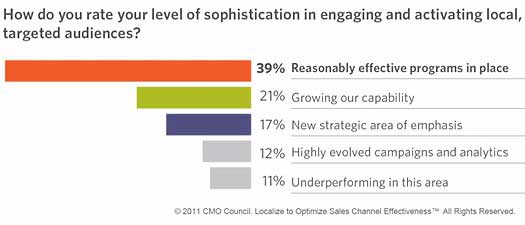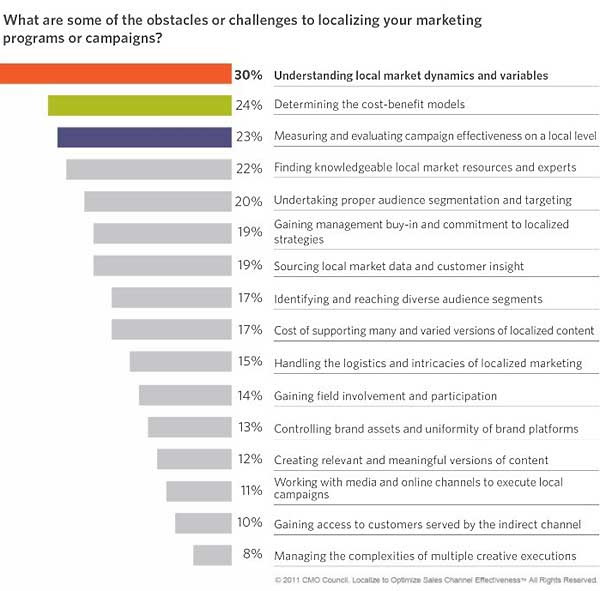Engaging local target audiences is a strategic focus for many brands: 49% of national marketers surveyed say localized marketing is essential to business growth and profitability, particularly as it relates to demand generation and sell-through of products and services, according to a study by the CMO Council.
Moreover, 86% of marketers say they intend to look for ways to better modify, adapt, and localize their marketing content, messaging, and prospect engagement practices.
Below, additional findings from the new report titled "Localize to Optimize Sales Channel Effectiveness" by the CMO Council.
Improvements Are Needed
Only 12% of marketers say they now have highly evolved campaigns and analytics on a local level, and 39% say they now have reasonable effective programs in place.

Roughly four in ten marketers are ramping up local marketing efforts, citing a new strategic emphasis (17%) or growing local marketing capabilities (21%), whereas 11% say they are underperforming in this area.
Top Local Marketing Channels
The most preferred channels cited for localized marketing are experiential and relationship-building events (57%), direct mail (52%), localized websites (51%), social networks (48%), public relations (45%), and electronic messaging (44%).

Traditional channels are less important to marketers for delivering messages to local audiences: Only 21% cite cable TV as a key channel; 22% cite broadcast television, 33% cite radio, and 31% cite local magazines.
Surprisingly, the Yellow Pages (online and offline) (7%) and local online deal delivery networks (6%) such as Groupon and LivingSocial, lag behind all channels of localized marketing choice for national brands.
Benefits of Local Marketing
Among the top benefits from localized marketing strategies and programs, marketers cite the following:
- Greater customer relevance, response, and return: 67%
- Better customer conversations and connectivity: 39%
- Improved loyalty and advocacy: 29%
- Brand differentiation, distinction and preference: 27%
Major obstacles or challenges to marketing localization include understanding local market dynamics or variables (30%), determining the right cost/benefit models when it comes to spend (24%), and measuring and evaluating campaign effectiveness on a local level (23%).

Also related to reaching the local customer, 20% of marketers cite undertaking audience segmentation and targeting as a key obstacle to localizing marketing campaigns, while 17% cite reaching diverse audiences segments. Some 12% cite creating relevant and meaningful local content as a key obstacle.
Looking for great digital marketing data? MarketingProfs reviewed hundreds of research sources to create our most recent Digital Marketing Factbook (May 2010), a 296-page compilation of data and 254 charts, covering email marketing, social media, search engine marketing, e-commerce, and mobile marketing. Also check out The State of Social Media Marketing, a 240-page original research report from MarketingProfs.
Factors That Influence Messaging
Asked to describe the factors that most influence localization of marketing messages, marketers cite demographics (45%), geography/location (44%), socioeconomic factors (28%), psychographic factors (27%), cultural factors (22%), shoppergraphic or buying history and behaviors (19%), and language (19%).
Tracking Local Market Business Development
Only 36% of marketers have a formalized process or system for tracking the impact of national brand advertising on local market development and customer acquisition.
Among those who do track the impact of national brand advertising on local business performance, the most common methods include response to offers or deals (45%), awareness and recognition studies (41%), lead and prospect flow (37%), website analytics (37%), field and channel feedback (31%), local inquiries and calls (30%), and share of market data (28%).
Other key findings:
- 30% of marketers have embraced local marketing automation platforms, resources, and tools compared with 62% who either don't have them or only now evaluating such options.
- 23% of marketing respondents allocate over 50% of their marketing and merchandising budgets to local programs; another 41% spend between 20% and 50% of the budgets on local marketing.
About the data: Findings from the online survey of 300 CMO Council members across all leading industry sectors, conducted in and second and third quarters of 2011. Most respondents hold senior marketing roles including CMO, EVP, SVP, VP, and director of marketing and communications.



